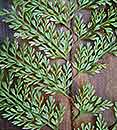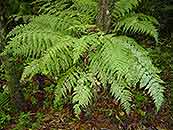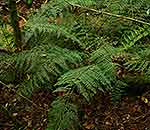Asplenium hypomelas Kuhn
Synonyms |
Davallia hollandii Sim |
|---|---|
Common name |
|
Description |
Rhizome erect, to 15 mm diameter; rhizome scales lanceolate in outline, glossy pale brown, up to 13 x 2.5 mm, hair-pointed, fimbriate. Fronds tufted, aching, not proliferous, herbaceous. Stipe 18-45 cm long, stipe and rhachis matt brown, sparsely set with hair-pointed scales. Lamina 50-100 × 19-50 cm, lanceolate in outline, 4-pinnate, acroscopic pinnules more developed, basal pinnae somewhat reduced. Pinnae up to 25 pairs, lanceolate in outline, up to 26 x 9 cm. Ultimate lobes c. 0.8-2 mm broad, hairless, oblanceolate, acute, margins entire. Sori cup-shaped, solitary, situated on the acroscopic side of the ultimate segments, protuding from the lobe margin, broadly oblong, 1-1.5 mm long; indusium entire, membranous, to 1 mm long/wide. |
Notes | Differs from similar species by having distinctive cup-shaped, protuding sori and finely divided fronds. |
Derivation | hypo: below and melas: black; probably a reference to the dark environment in which this fern grows |
Habitat | Deeply shaded evergreen forest, often on tree ferns, sometimes terrestrial, rarely on rock. |
Distribution worldwide | See African distribution. |
Distribution in Africa |
Angola, Burundi, Cameroon, Congo, Dem. Republic of Congo, Equatorial Guinea (incl. Bioko), Ethiopia, Guinea, Kenya, Liberia, Malawi, Mozambique, Rwanda, Sierra Leone, South Africa, Sudan and South Sudan, Tanzania , Uganda, Zimbabwe. |
Growth form |
Epiphytic. |
Literature |
|



